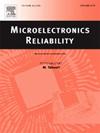500 μm heavy micro-alloyed Cu wire for IGBT application: The study on microstructure characteristics, electrical fatigue fracture mechanism and bonding reliability
IF 1.6
4区 工程技术
Q3 ENGINEERING, ELECTRICAL & ELECTRONIC
引用次数: 0
Abstract
In this study, we introduced trace amounts of silver and nickel into 500 μm diameter copper wires to form micro-alloyed copper wires used in insulated gate bipolar transistors (IGBT). The addition of silver and nickel enhanced the mechanical properties of the conductors and suppressed the work hardening effect, significantly improving the power cyclic lifetime. Additionally, this study conducted chlorination and high-temperature oxidation test to compare the application characteristics of the heavy micro-alloyed copper wires with pure copper wires, through tensile and bending test, as well as electrical property comparisons. Finally, Cu![]() 50Ni (50 ppm Ni) wires were selected and nickel ceramic substrates for wire bonding to evaluate module electrical properties and bonding reliability.
50Ni (50 ppm Ni) wires were selected and nickel ceramic substrates for wire bonding to evaluate module electrical properties and bonding reliability.
In the chloride test, there was no significant pitting corrosion observed in copper wire, and the micro-alloyed copper wire outperformed the pure copper wires in terms of bending lifetime and power cycling performance. In the high-temperature oxidation test, an oxide layer of cuprous oxide formed on the surface of all wires. The pure copper wire exhibited a significant increase in resistance. Notably, the micro-alloyed copper wires had better resistance to oxidation. Regarding wire bonding, the use of Cu![]() 50Ni wires and nickel ceramic substrates reduced the diffusion rate of nickel atoms from the substrate to the copper wire, forming a thinner alloy diffusion layer. This prevented electrical degradation and achieved high bonding reliability, especially under higher bonding forces. These findings confirm that micro-alloyed copper wires are suitable for high-power applications.
50Ni wires and nickel ceramic substrates reduced the diffusion rate of nickel atoms from the substrate to the copper wire, forming a thinner alloy diffusion layer. This prevented electrical degradation and achieved high bonding reliability, especially under higher bonding forces. These findings confirm that micro-alloyed copper wires are suitable for high-power applications.
用于 IGBT 的 500 μm 重微合金铜线:微观结构特征、电疲劳断裂机制和接合可靠性研究
在这项研究中,我们在直径为 500 μm 的铜线中加入了微量的银和镍,以形成用于绝缘栅双极晶体管 (IGBT) 的微合金铜线。银和镍的添加增强了导体的机械性能,抑制了加工硬化效应,从而显著提高了功率循环寿命。此外,本研究还进行了氯化和高温氧化试验,通过拉伸和弯曲试验以及电气性能比较,比较了重微合金铜线与纯铜线的应用特性。最后,选择了 Cu50Ni(镍含量为 50 ppm)铜线和镍陶瓷基板进行接线,以评估模块的电气性能和接线可靠性。在氯化试验中,铜线没有出现明显的点腐蚀现象,微合金铜线在弯曲寿命和功率循环性能方面优于纯铜线。在高温氧化试验中,所有铜线的表面都形成了氧化亚铜层。纯铜线的电阻明显增加。值得注意的是,微合金铜线的抗氧化性更好。在铜线键合方面,使用 Cu50Ni 铜线和镍陶瓷基底降低了镍原子从基底向铜线的扩散速度,形成了更薄的合金扩散层。这防止了电性能下降,实现了较高的键合可靠性,尤其是在较高的键合力下。这些研究结果证实,微合金铜线适用于大功率应用。
本文章由计算机程序翻译,如有差异,请以英文原文为准。
求助全文
约1分钟内获得全文
求助全文
来源期刊

Microelectronics Reliability
工程技术-工程:电子与电气
CiteScore
3.30
自引率
12.50%
发文量
342
审稿时长
68 days
期刊介绍:
Microelectronics Reliability, is dedicated to disseminating the latest research results and related information on the reliability of microelectronic devices, circuits and systems, from materials, process and manufacturing, to design, testing and operation. The coverage of the journal includes the following topics: measurement, understanding and analysis; evaluation and prediction; modelling and simulation; methodologies and mitigation. Papers which combine reliability with other important areas of microelectronics engineering, such as design, fabrication, integration, testing, and field operation will also be welcome, and practical papers reporting case studies in the field and specific application domains are particularly encouraged.
Most accepted papers will be published as Research Papers, describing significant advances and completed work. Papers reviewing important developing topics of general interest may be accepted for publication as Review Papers. Urgent communications of a more preliminary nature and short reports on completed practical work of current interest may be considered for publication as Research Notes. All contributions are subject to peer review by leading experts in the field.
 求助内容:
求助内容: 应助结果提醒方式:
应助结果提醒方式:


